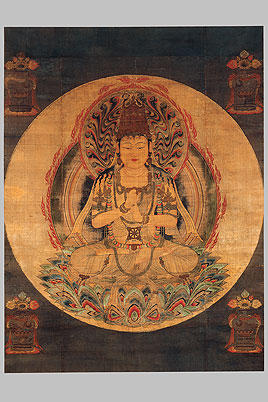
Ritual and Religious Objects
 |
Dainichi Nyorai in the Form of Ichiji Kinrin Buccho (Buddha Vairochana in the Form of Ekaksara-ushnisha-chakra) Japan Nanbokucho period (1333�1392), 14th century Hanging scroll; ink, color, and gold on silk Image only, H. 43 1/2 in. x W. 32 5/8 in. (110.5 cm x 82.9 cm) Asia Society, New York: Mr. and Mrs. John D. Rockefeller 3rd Collection, 1979.207 |
This painting of Dainichi Nyorai (Sanskrit: Mahavairocana; Great Sun Buddha) is mounted as a hanging scroll (Japanese: kakemono). The hanging scroll format may have developed in China from Buddhist sacred texts that were rolled for storage and easy transportation. Japanese mounting techniques developed from Chinese prototypes, which were probably imported into Japan along with Esoteric Buddhism during the Heian period (794-1185). In Buddhist temples hanging scrolls were originally displayed on the walls of the main building of the Buddhist temple complex.
Dainichi Nyorai is thought to be the embodiment of the universe. In Japan, he is the central and supreme deity of the pantheon of Esoteric Buddhism and was worshiped as early as the Heian period. In this painting, the "five-wisdom bejeweled crown" on his head with five miniature images of Buddhas symbolizes his identity. His distinctive hand gestures are one of the signs that identify him. In this work, he forms the "seal of the knowledge fist" mudra, with his clenched right hand posed over the extended index finger of his otherwise clenched left hand.